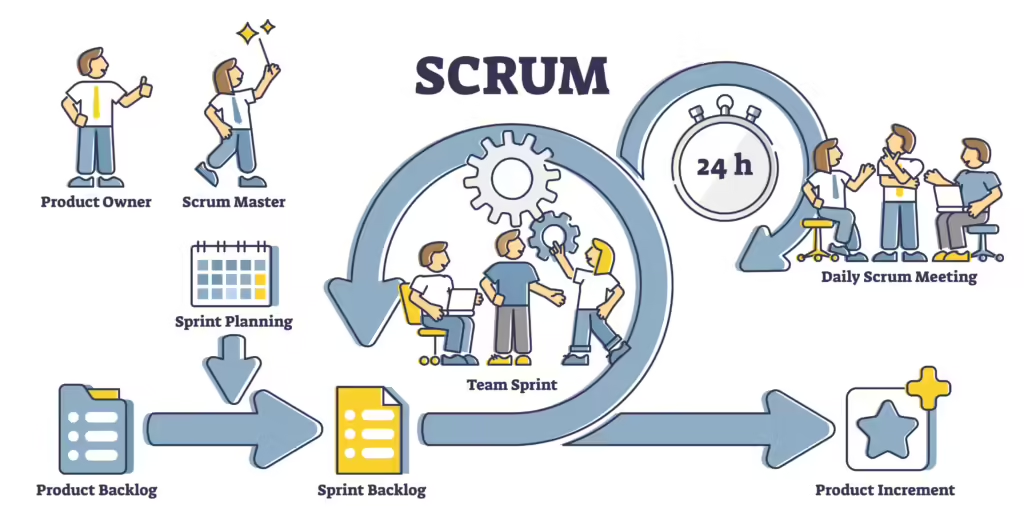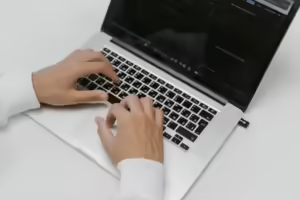Agile software development is a flexible, iterative approach to developing software based on collaboration, continuous improvement, and rapid feedback. The goal of the agile method is to deliver software in small, manageable steps rather than working in a long, rigid development cycle. This allows teams to respond quickly to changes and continuously adapt the software to customer needs.
The most important features of agile software development:
1. Iterative development:
The software is developed in small increments, with each iteration delivering a working version of the product. These increments are released at regular intervals, often in periods of 1-4 weeks (called sprints in Scrum).Why is this important? In the past, large software packages were developed based on extensive concepts that described the functionality in the smallest details. The problem with the so-called "waterfall model" is that stakeholders often do not know exactly how the software should work in advance. In the end, after several years, they receive a software package that does not reflect the actual needs, but only implements the concept. In addition, it is almost impossible for the company developing the software to estimate the exact effort of such a large project. In order to avoid possible losses, the effort is often overestimated, which makes the project more expensive.
If the customer is dissatisfied with the work of a software company, he cannot change it because they were commissioned to provide the entire software package.
2. customer focus:
Agile development puts the customer at the center. Regular feedback is important to ensure that the software meets requirements and that problems are identified early.
What is the point? Regular meetings - so-called reviews in Scrum - are not only important for presenting the new software version to the customer and discussing new functions, but also for developing a common understanding of the needs of both sides. The software company gets to know the customer's business processes and requirements better, and the customer learns what information the developers need for effective implementation. This allows the developers to implement many things correctly without discussing every detail in advance. It is therefore important that as many developers, stakeholders and future users as possible take part in these meetings.
3. flexibility and adaptability:
Agile methods enable flexible adaptation to changing requirements, even late in the development process. Instead of following a fixed plan, teams adapt to new findings or customer requests.
What is the point? Business processes often change quickly. The software must be adapted as quickly as possible to deliver the right functionality. Often, when the new software version is presented, the customer says: "Ah, that's what it looks like? Then I want it to be different, that would be much better for us." And even if the development team has misunderstood something, very little time is lost because adjustments can be made in the next sprint.
4. teamwork and self-organization:
Agile teams work closely together and largely organize themselves. Regular meetings such as daily standups or retrospectives are used to discuss progress and remove obstacles.
Why is this important? Software developers are often highly qualified engineers who have to implement complex functionalities in a technical language. Establishing a hierarchy in the development team would be counterproductive, as the supervisor would have to understand the complexity of all functions in order to make informed decisions - which is hardly possible. In addition, self-organization promotes the motivation of team members, as they can work independently within the framework of the predefined goals and tasks of the current sprint.
5. transparency and communication:
Agile processes rely on open and constant communication within the team and with stakeholders. Progress, task allocation and goals are clearly visible to everyone involved.
Why is communication essential? Constant communication allows potential problems or errors to be identified early on. It also increases the effectiveness of teamwork, as team members receive immediate help if something is unclear. Communication and transparency towards the customer is also very important, as it strengthens trust between partners and increases work efficiency.
6. Continuous Improvement:
After each sprint or iteration, a review or retrospective is held to analyze what worked well and what can be improved. The team then implements these findings in the next iteration.
Why is this important? A system that does not change and adapt is fundamentally doomed to failure. The retrospective is therefore an integral part of the agile process. This planned meeting offers the team or the customer a platform to address topics for which there is often no time in everyday life. This encourages everyone to think about how the process can be specifically improved in order to make development even more effective.
Agile Frameworks
There are various frameworks and methods that fall under the term “agile software development”. The most well-known are:
- Scrum: A widely used framework that uses iterative and incremental processes. Sprints, product backlog and roles such as Scrum Master and Product Owner are characteristic.
- Kanban: A visual approach that organizes tasks on a board according to their status (e.g., To Do, In Progress, Done) to streamline workflow.
- Extreme Programming (XP): A method that focuses heavily on technical practices such as pair programming, test-driven development (TDD), and frequent releases.
Advantages of agile software development:
- Ability to respond quickly to changes and customer feedback.
- Deliver working software early and often.
- Better collaboration between teams and stakeholders.
- Reduced risks because problems are identified and solved in short cycles.
Summary
Agile software development offers a flexible and adaptive approach that allows projects to be planned and adapted in short iterations. Since a working version is available after each iteration or sprint, the customer can use the functionality they need most much faster, thus increasing their competitiveness in the market.
Agile software development promotes collaboration, continuous feedback, and rapid response to changing requirements, resulting in faster, higher-quality software development.
This revision provides better readability and linguistic precision, while retaining the content and core messages.
About the author
Katarina Schaffler-Glössl has a master's degree in computer science from the Technical University of Bratislava. For more than 25 years she has worked successfully in individual software development for medium to very large companies. She is the founder of CIIT GmbH, which has been developing customized software solutions for its customers for over 20 years.






